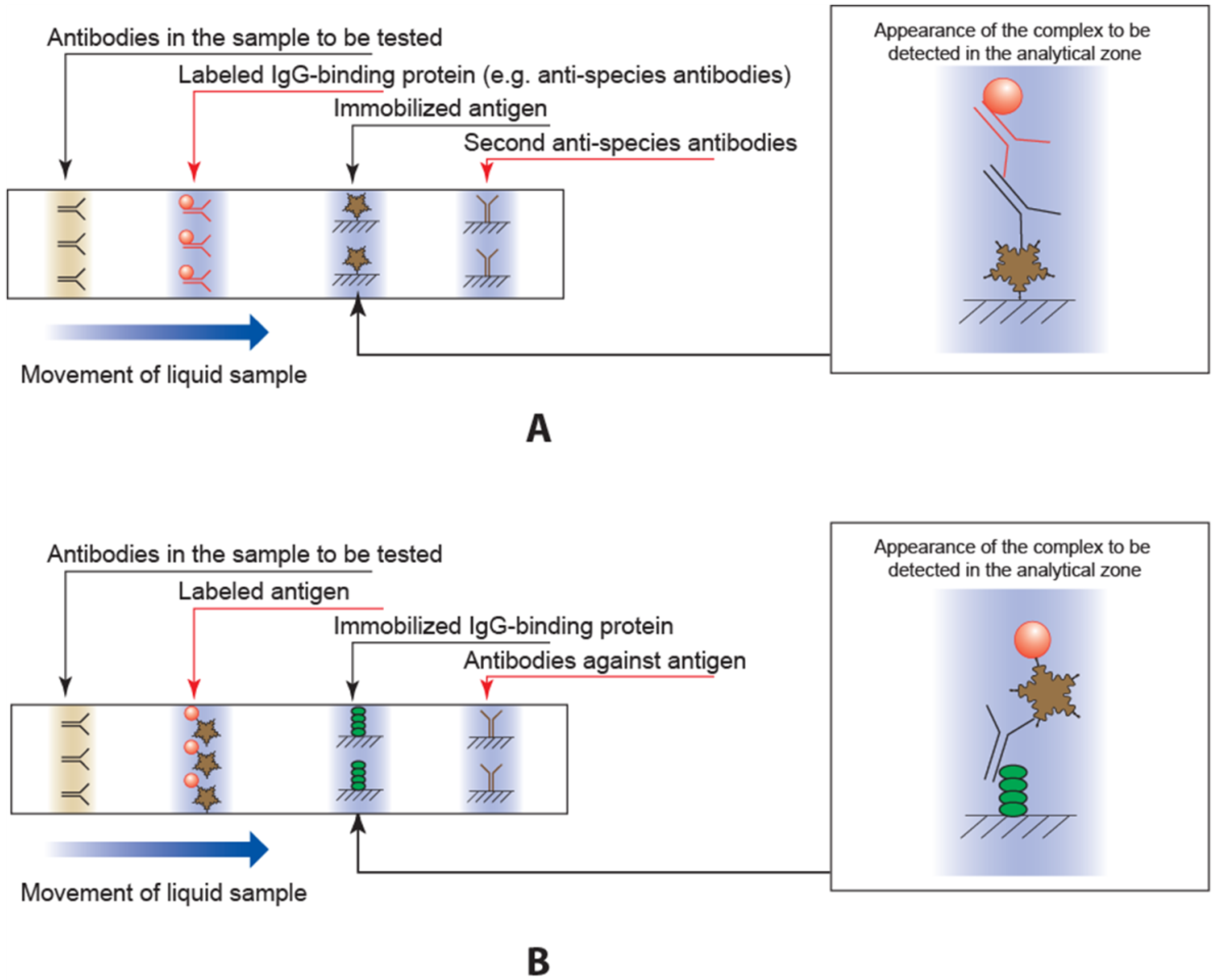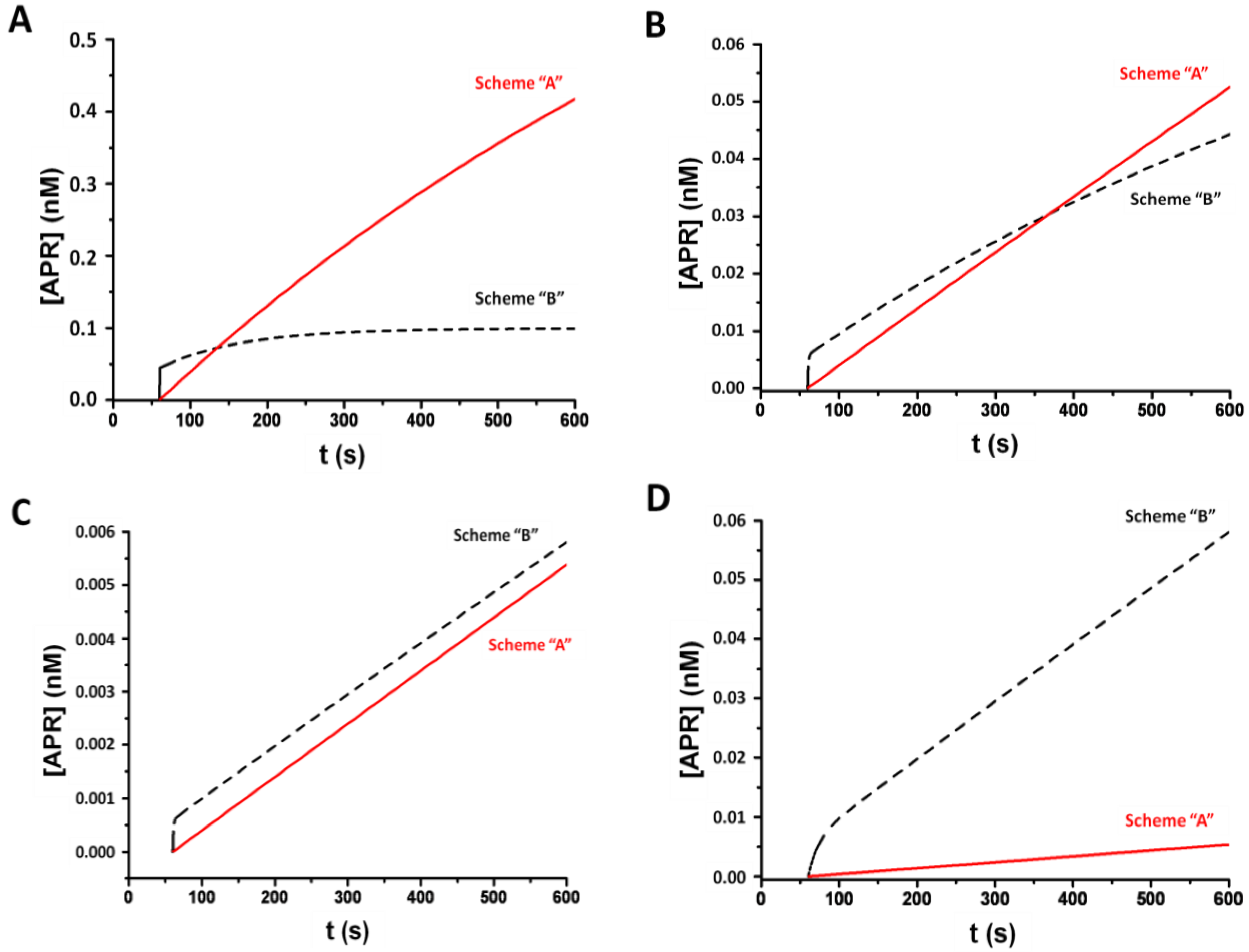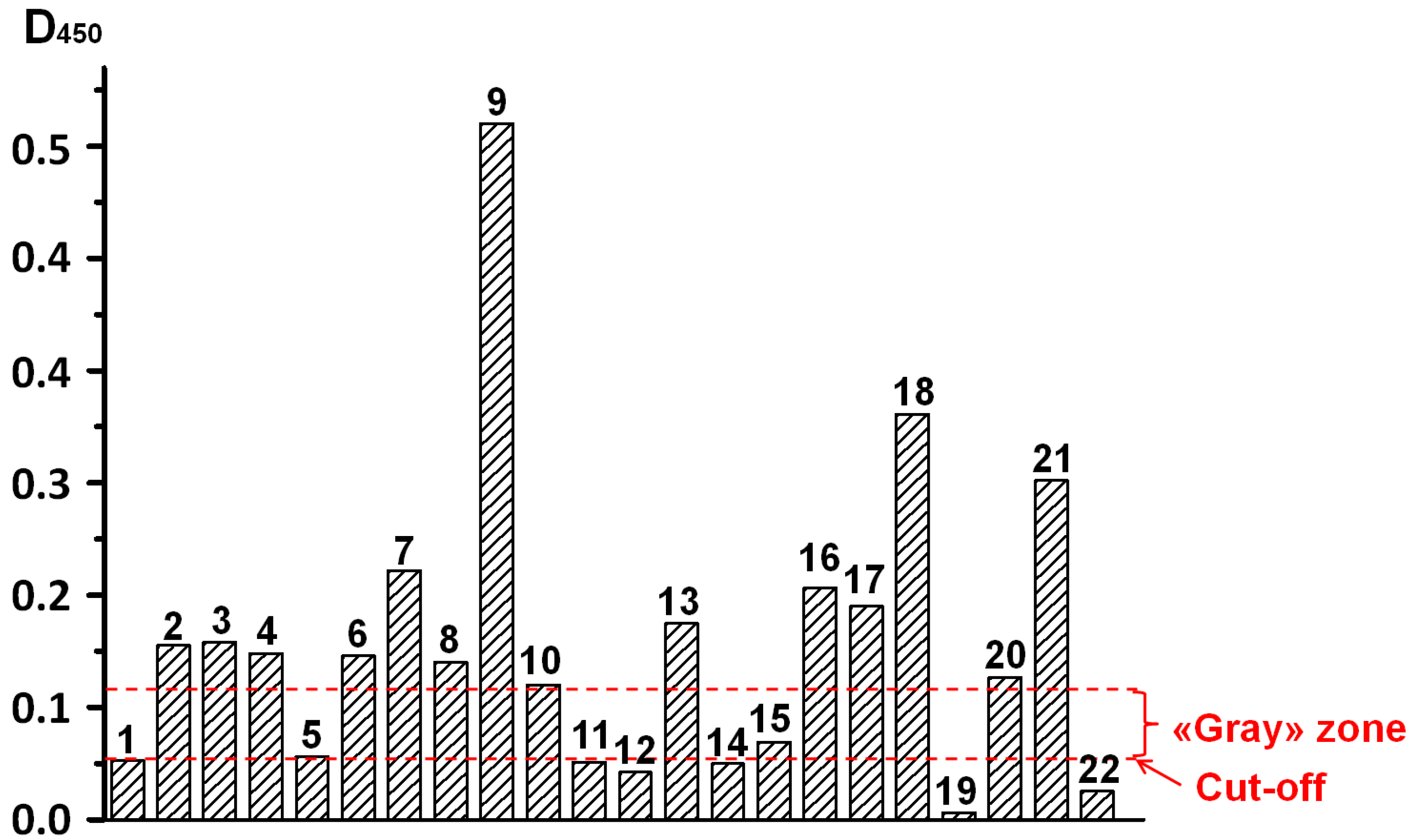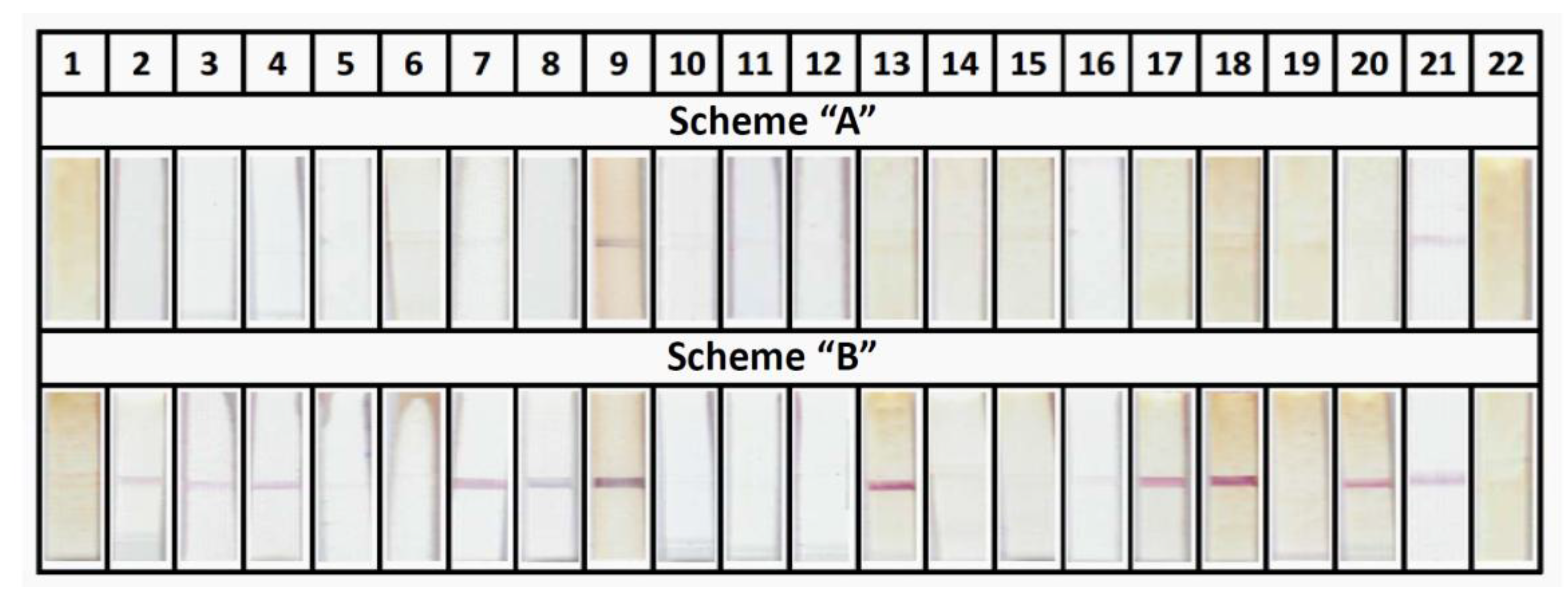Theoretical and Experimental Comparison of Different Formats of Immunochromatographic Serodiagnostics
Abstract
:1. Introduction
2. Materials and Methods
2.1. Reagents
2.2. Immunoenzyme Assay of Specific Antibodies in Serum Samples
2.3. Synthesis of Gold Nanoparticles
2.4. Conjugation of Protein A and Antigen Rv0934 with Gold Nanoparticles
2.5. Application of Reagents onto Immunochromatographic Membranes
2.6. Preparation of Immunochromatographic Test Strips
2.7. Immunochromatographic Serodiagnostic Assay
3. Results and Discussion
3.1. Designations and Consumptions in Scheme B Modeling
- A—immunoglobulins in the sample
- P—active molecules of the antigen immobilized on gold nanoparticles
- R—active molecules of immunoglobulin-binding protein immobilized in the analytic zone
- AP—complex of immunoglobulin with an immunoglobulin-binding protein that is immobilized on a gold nanoparticle surface
- AR—complex of immunoglobulins with an antigen in the analytic zone
- APR—complex of specific immunoglobulins with gold conjugate and an antigen in the analytic zone
- Кai—equilibrium association constant of the i-th reaction
- kai—kinetic association constant of the i-th reaction
- kdi—kinetic dissociation constant of the i-th reaction
- t—time of reaction from the beginning of the sample’s contact with the gold conjugate
- t1—time of reaction in the analytic zone
- x—proportion of specific immunoglobulins in the total immunoglobulins pool
- The flow of the liquid sample along the test strip occurred evenly.
- Two stages of the analysis were considered: in Stage 1, the conjugate of antigen and gold nanoparticle interacted with the immunoglobulins in the sample until the analytic zone was reached (Reaction (1)); in Stage 2, the immunoglobulins interacted with the immunoglobulin-binding protein and the antigen–gold nanoparticle conjugate in the analytic zone (Reactions (2) and (3)).
- Components A and P were uniformly distributed in the reaction volume of the liquid sample, and reagent R was uniformly distributed within the analytic zone (Figure 2). The boundary of the analytic zone was permeable for reagents A and P and their complex, but it was impermeable to R and its complexes AR and APR. The uniform distribution of the components within the reaction volumes meant the interaction processes were homogeneous.
- Polyvalent interactions were not taken into account.
- Subpopulations of antibodies with different affinities to the antigen were not taken into account.
- The antibodies did not change the constant of their binding to the immunoglobulin-binding protein after interaction with the antigen or to the antigen after interaction with the immunoglobulin-binding protein; ka1 ≈ ka4; ka2 ≈ ka3.
3.2. Consideration of the Model: Stage 1
3.3. Consideration of the Model: Stage 2
3.4. Theoretical Comparison of 2 Schemes of Immunochromatographic Serodiagnosis
3.5. Testing Patients’ Serum Using ELISA
3.6. Experimental Comparison of 2 Schemes of Immunochromatographic Serodiagnosis
4. Conclusions
Acknowledgments
Author Contributions
Conflicts of Interest
Appendix A. The Solution of the Differential Equation (15)
References
- Wild, D. The Immunoassay Handbook, 3rd ed.; Elsevier Ltd.: Kidlington, UK, 2005; p. 930. ISBN 0080445268. [Google Scholar]
- Parija, S.C. Textbook of Microbiology & Immunology—E-Book, 2nd ed.; Reed Elsevier India Pvt. Ltd.: Haryana, India, 2012; p. 684. ISBN 9788131228104. [Google Scholar]
- Tille, P. Bailey & Scott’s Diagnostic Microbiology—E-Book, 13th ed.; Elsevier Ltd.: St. Louis, MO, USA, 2013; p. 1056. ISBN 9780323083300. [Google Scholar]
- Von Lode, P. Point-of-care immunotesting: Approaching the analytical performance of central laboratory methods. J. Clin. Biochem. 2005, 38, 591–606. [Google Scholar] [CrossRef] [PubMed]
- Wong, R.C.; Tse, H.Y. Lateral Flow Immunoassay; Humana Press: New York, NY, USA, 2009; p. 224. ISBN 9781597452403. [Google Scholar]
- Raeisossadati, M.J.; Danesh, N.M.; Borna, F.; Gholamzad, M.; Ramezani, M.; Abnous, K.; Taghdisi, S.M. Lateral flow based immunobiosensors for detection of food contaminants. Biosens. Bioelectron. 2016, 86, 235–246. [Google Scholar] [CrossRef] [PubMed]
- Bahadır, E.B.; Sezgintürk, M.K. Lateral flow assays: Principles, designs and labels. TRAC Trends Anal. Chem. 2016, 82, 286–306. [Google Scholar] [CrossRef]
- Sotnikov, D.V.; Byzova, N.A.; Zherdev, A.V.; Eskendirova, S.Z.; Baltin, K.K.; Mukanov, K.K.; Ramankulov, E.M.; Sadykhov, E.G.; Dzantiev, B.B. Express immunochromatographic detection of antibodies against Brucella Abortus in cattle sera based on quantitative photometric registration and modulated cut-off level. J. Immunoass. Immunochem. 2015, 36, 80–90. [Google Scholar] [CrossRef] [PubMed]
- Nakano, S.; Tsukimura, T.; Togawa, T.; Ohashi, T.; Kobayashi, M.; Takayama, K.; Kobayashi, Y.; Abiko, H.; Satou, M.; Nakahata, T.; et al. Rapid immunochromatographic detection of serum anti-α-galactosidase A antibodies in fabry patients after enzyme replacement therapy. PLoS ONE 2015, 10, e0128351. [Google Scholar] [CrossRef] [PubMed]
- Janwan, P.; Intapan, P.M.; Yamasaki, H.; Rodpai, R.; Laummaunwai, P.; Thanchomnang, T.; Sanpool, O.; Kobayashi, K.; Takayama, K.; Kobayashi, Y.; et al. Development and usefulness of an immunochromatographic device to detect antibodies for rapid diagnosis of human gnathostomiasis. Parasit. Vectors 2016, 9, 14. [Google Scholar] [CrossRef] [PubMed]
- Khan, I.H.; Sayeed, M.A.; Sultana, N.; Islam, K.; Amin, J.; Faruk, M.O.; Khan, U.; Khanam, F.; Ryan, E.T.; Qadri, F. Development of a simple, peripheral-blood-based lateral-flow dipstick assay for accurate detection of patients with enteric fever. Clin. Vaccine Immunol. 2016, 23, 403–409. [Google Scholar] [CrossRef] [PubMed]
- Mdluli, P.; Tetyana, P.; Sosibo, N.; van der Walt, H.; Mlambo, M.; Skepu, A.; Tshikhudo, R. Gold nanoparticle based tuberculosis immunochromatographic assay: The quantitative ESE Quanti analysis of the intensity of test and control lines. Biosens. Bioelectron. 2014, 54, 1–6. [Google Scholar] [CrossRef] [PubMed]
- Vrublevskaya, V.V.; Afanasyev, V.N.; Grinevich, A.A.; Skarga, Y.Y.; Gladyshev, P.P.; Ibragimova, S.A.; Krylsky, D.V.; Dezhurov, S.V.; Morenkov, O.S. A sensitive and specific lateral flow assay for rapid detection of antibodies against glycoprotein B of Aujeszky’s disease virus. J. Virol. Methods 2017, 249, 175–180. [Google Scholar] [CrossRef] [PubMed]
- Martínez-Sernández, V.; Muiño, L.; Perteguer, M.J.; Gárate, T.; Mezo, M.; González-Warleta, M.; Muro, A.; Costa, J.M.C.; Romarís, F.; Ubeira, F.M. Development and evaluation of a new lateral flow immunoassay for serodiagnosis of human fasciolosis. PLoS Negl. Trop. Dis. 2011, 5, e1376. [Google Scholar] [CrossRef] [PubMed]
- Ben-Selma, W.; Harizi, H.; Boukadida, J. Immunochromatographic IgG/IgM test for rapid diagnosis of active tuberculosis. Clin. Vaccine Immunol. 2011, 18, 2090–2094. [Google Scholar] [CrossRef] [PubMed]
- Sotnikov, D.V.; Zherdev, A.V.; Avdienko, V.G.; Dzantiev, B.B. Immunochromatographic assay for serodiagnosis of tuberculosis using an antigen-colloidal gold conjugate. Appl. Biochem. Microbiol. 2015, 51, 834–839. [Google Scholar] [CrossRef]
- Sotnikov, D.V.; Zherdev, A.V.; Dzantiev, B.B. Mathematical model of serodiagnostic immunochromatographic assay. Anal. Chem. 2017, 89, 4419–4427. [Google Scholar] [CrossRef] [PubMed]
- Frens, G. Controlled nucleation for the regulation of the particle size in monodisperse gold suspensions. Nat. Phys. Sci. 1973, 241, 20–22. [Google Scholar] [CrossRef]
- Hermanson, G.T. Bioconjugate Techniques, 3rd ed.; Academic Press: New York, NY, USA, 2013; p. 1200. ISBN 9780123822390. [Google Scholar]
- Landry, J.P.; Ke, Y.; Yu, G.L.; Zhu, X.D. Measuring affinity constants of 1450 monoclonal antibodies to peptide targets with a microarray-based label-free assay platform. J. Immunol. Methods 2015, 417, 86–96. [Google Scholar] [CrossRef] [PubMed]
- Atkins, P.; de Paula, J. Physical Chemistry, 8th ed.; W.H. Freeman and Company: New York, NY, USA, 2006; p. 802. ISBN 9781428895683. [Google Scholar]
- Meulenbroek, A.J. Human IgG Subclasses: Useful Diagnostic Markers for Immunocompetence, 3rd ed.; Sanquin: Amsterdam, The Netherlands, 2008; p. 15. ISBN 9052670110. [Google Scholar]
- Kemper, M.J.; Altrogge, H.; Ganschow, R.; Müller-Wiefel, D.E. Serum levels of immunoglobulins and IgG subclasses in steroid sensitive nephrotic syndrome. Pediatr. Nephrol. 2002, 17, 413–417. [Google Scholar] [CrossRef] [PubMed]
- Tuerlinckx, D.; Florkin, B.; Ferster, A.; De Schutter, I.; Chantrain, C.; Haerynck, F.; Philippet, P.; Strengers, P.; Laub, R. Pneumococcal antibody levels in children with PID receiving immunoglobulin. Pediatrics 2014, 133, e154–e162. [Google Scholar] [CrossRef] [PubMed]
- Turner, P.; Turner, C.; Green, N.; Ashton, L.; Lwe, E.; Jankhot, A.; Day, N.P.; White, N.J.; Nosten, F.; Goldblatt, D. Serum antibody responses to pneumococcal colonization in the first 2 years of life: results from an SE Asian longitudinal cohort study. Clin. Microbiol. Infect. 2013, 19, E551–E558. [Google Scholar] [CrossRef] [PubMed]
- Goldammer, A.; Derfler, K.; Herkner, K.; Bradwell, A.R.; Hörl, W.H.; Haas, M. Influence of plasma immunoglobulin level on antibody synthesis. Blood 2002, 100, 353–355. [Google Scholar] [CrossRef] [PubMed]
- Vashist, S.K.; Luppa, P.B.; Yeo, L.Y.; Ozcan, A.; Luong, J.H.T. Emerging technologies for next-generation point-of-care testing. Trends Biotechnol. 2015, 33, 692–705. [Google Scholar] [CrossRef] [PubMed]





| Serum Number | ELISA | ICA, Scheme A | ICA, Scheme B | |||
|---|---|---|---|---|---|---|
| OD450 | Qualitative Result | Color Intensity * | Qualitative Result | Color Intensity * | Qualitative Result | |
| 1 | 0.053 | – | 0 | – | 0.5 | – |
| 2 | 0.155 | + | 0 | – | 2.2 | + |
| 3 | 0.158 | + | 0 | – | 1.9 | + |
| 4 | 0.148 | + | 0 | – | 3.4 | + |
| 5 | 0.056 | ± | 0 | – | 0.5 | – |
| 6 | 0.146 | + | 0.2 | – | 0.4 | – |
| 7 | 0.222 | + | 0.1 | – | 6.8 | + |
| 8 | 0.140 | + | 0 | – | 4.1 | + |
| 9 | 0.620 | + | 3.9 | + | 11.0 | + |
| 10 | 0.120 | + | 0.2 | – | 0.3 | – |
| 11 | 0.051 | – | 0.1 | – | 0 | – |
| 12 | 0.042 | – | 0 | – | 0 | – |
| 13 | 0.175 | + | 0.2 | – | 8.5 | + |
| 14 | 0.050 | – | 0 | – | 0 | – |
| 15 | 0.069 | ± | 0.2 | – | 0 | – |
| 16 | 0.206 | + | 0 | – | 0.7 | + |
| 17 | 0.190 | + | 0.1 | – | 7.7 | + |
| 18 | 0.361 | + | 0 | – | 12.1 | + |
| 19 | 0.006 | – | 0 | – | 0 | – |
| 20 | 0.127 | + | 0 | – | 6.5 | + |
| 21 | 0.302 | + | 2.4 | + | 4.3 | + |
| 22 | 0.025 | – | 0.5 | – | 0.3 | – |
© 2017 by the authors. Licensee MDPI, Basel, Switzerland. This article is an open access article distributed under the terms and conditions of the Creative Commons Attribution (CC BY) license (http://creativecommons.org/licenses/by/4.0/).
Share and Cite
Sotnikov, D.V.; Zherdev, A.V.; Dzantiev, B.B. Theoretical and Experimental Comparison of Different Formats of Immunochromatographic Serodiagnostics. Sensors 2018, 18, 36. https://doi.org/10.3390/s18010036
Sotnikov DV, Zherdev AV, Dzantiev BB. Theoretical and Experimental Comparison of Different Formats of Immunochromatographic Serodiagnostics. Sensors. 2018; 18(1):36. https://doi.org/10.3390/s18010036
Chicago/Turabian StyleSotnikov, Dmitriy V., Anatoly V. Zherdev, and Boris B. Dzantiev. 2018. "Theoretical and Experimental Comparison of Different Formats of Immunochromatographic Serodiagnostics" Sensors 18, no. 1: 36. https://doi.org/10.3390/s18010036






